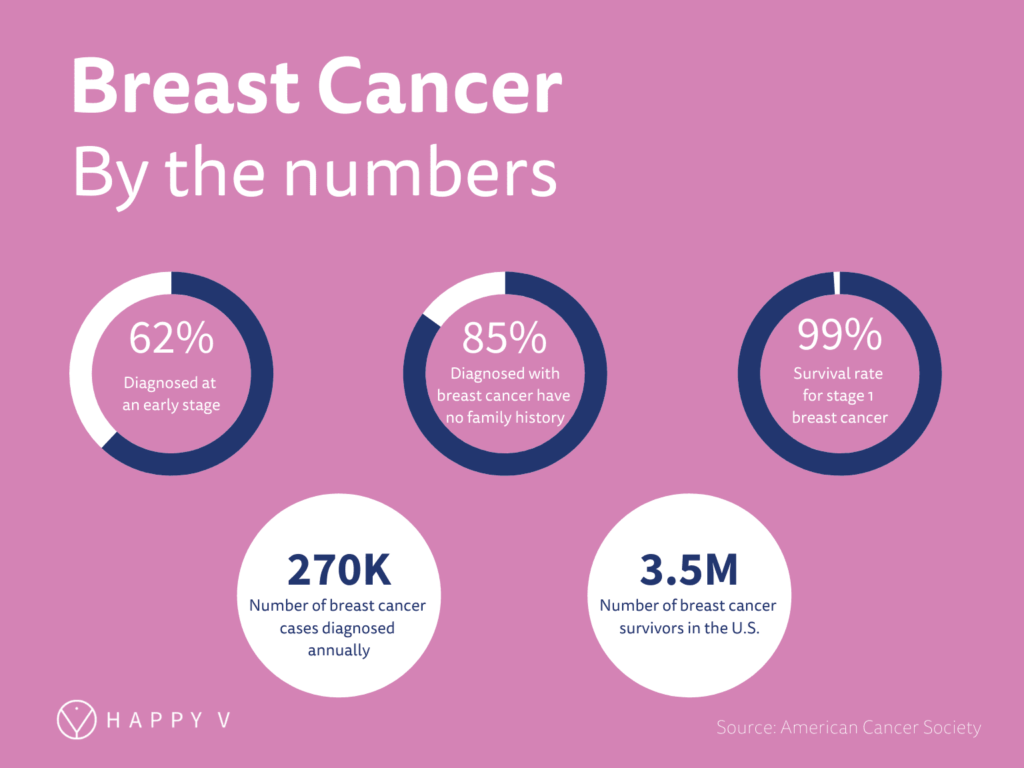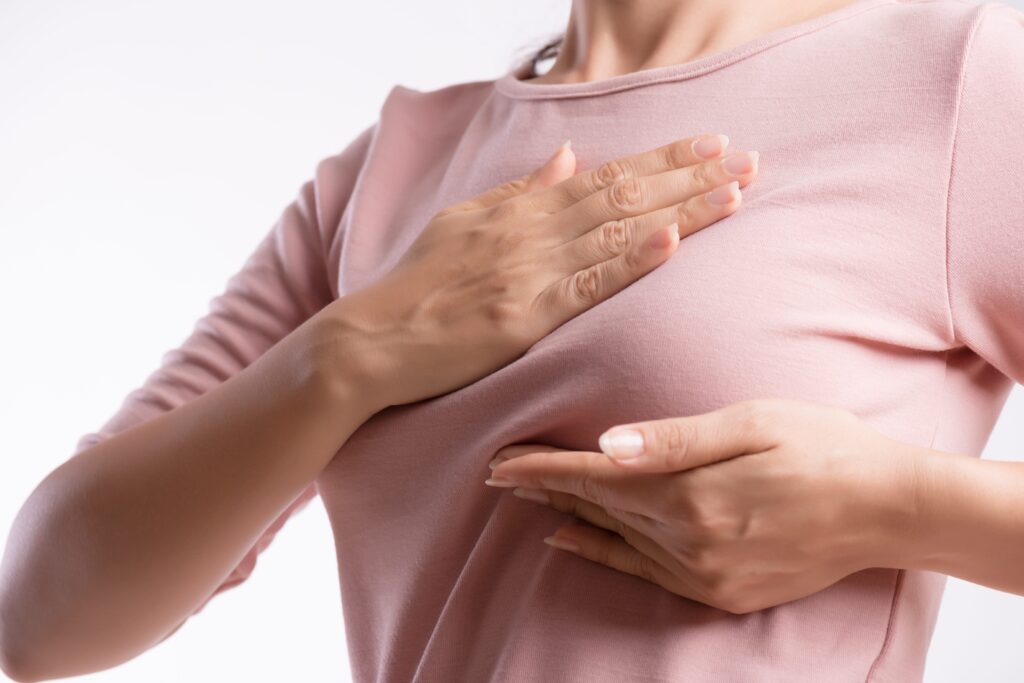- Approximately 1 in 8 women will develop breast cancer at some point in their lifetime.
- Цhen caught early, there is a 99% 5-year survival rate.
- There are over 3.8 million breast cancer survivors in the United States.
- 2 out of 3 women who have invasive, metastatic cancer are diagnosed with breast cancer after the age of 55.
- There are two gene mutations that increase your risk of developing breast cancer from about 12% to 65% in your lifetime. These are BRCA1 and BRCA2 – mutations of the BRCA gene, which usually works as a known tumor suppressor.
- Detecting breast cancer early improves your 5-year survival rate significantly, and either you or your partner may be able to identify tissue changes before cancer progresses.
- Eliminating unhealthy habits and introducing healthy lifestyle factors such as maintaining healthy body weight and eating a varied and nutritious diet, are all controllable factors that may help you reduce your risk of developing any cancer.
October is National Breast Cancer Awareness Month, and here at Happy V, we’re keeping you informed on how to protect yourself, and raise awareness of breast cancer.
What is Breast Cancer and How is it Caused?
Cancer is the name for a broad condition in which cells divide, or proliferate, at an abnormal rate in your body. Once cancerous cells start to spread, they may invade healthy tissue in multiple parts of the body; particularly the lymph nodes nearby in your armpit area. This is known as metastasizing.
Breast cancer refers to cancerous cells that start in the breast tissue (1).
Breast cancer statistics

Approximately 1 in 8 women will develop breast cancer at some point in their lifetime. While a serious condition, when caught early (when no cancer is found outside of the breast tissue), there is a 99% 5-year survival rate. This is why regular checks, preventative measures, and early detection are so important for all women, no matter their age.

There are over 3.8 million breast cancer survivors in the United States. While treatment is always improving, there is still no cure for cancer, however, there are various research institutions that are pushing breast cancer research (2).
Who is at Risk of Breast Cancer?
- Women age 55 or older
- Those with alcohol use disorders
- Women with dense breast tissue
- Those who started menstruation early, or the menopause late
- Perimenopausal or menopausal women who are taking hormone therapy
- Women who have an inherited risk (3)
Does menopause increase my risk of breast cancer?
While menopause does not directly increase your risk of breast cancer, there are many individual factors that may increase your risk, that occur as a result of menopause.
2 out of 3 women who have invasive, metastatic cancer are diagnosed with breast cancer after the age of 55. This is around the age when women are going through perimenopause or menopause (4). In addition, women who start menopause late are more likely to develop breast cancer. If you start perimenopause after the age of 55, this is considered late (the average age of menopause in the United States is 52) (5).
Many women are prescribed hormone therapy, or hormone-replacement therapy, to help them cope with the symptoms of menopause, such as hot flashes, mood changes, and difficulty with vaginal dryness. However, taking prescription, bioidentical female hormones can increase your risk of developing breast cancer. It also increases your risk of being diagnosed at a later, and less easily treatable, stage (4). Furthermore, due to estrogen sensitivity, breast cancer survivors are not an appropriate candidate for hormone replacement therapy (6).
If you are going through menopause or are a breast cancer survivor, and are concerned about the risk of hormone therapy and the side effects, you may want to explore natural, drug-free supplementation that can offer relief without the increased risk of developing breast cancer. You can rest assured that products like Happy V® Menopause Relief contain the most effective, drug-free ingredients to offer relief from symptoms like hot flashes, vaginal dryness; mood, energy, and weight changes.
What are the genetic risks for breast cancer?
There are two gene mutations that increase your risk of developing breast cancer from about 12% to 65% in your lifetime. These are BRCA1 and BRCA2 – mutations of the BRCA gene, which usually works as a known tumor suppressor. These genes are inherited, and if you have a history of the mutation in your family tree, you can be tested to find out your risk (7).
Genetic testing can be scary, and we are here to empower you with information about your health, breast cancer, and the treatment options available to you.
Breast Cancer Symptoms
Like most cancers, there are a number of symptoms that are non-specific to breast cancer. These include weight loss, fatigue, nausea, vomiting, and swelling of the lymph nodes (8). However, there are some symptoms specific to breast cancer that you should have checked by your physician as soon as possible:
- Finding lumps in your breast tissue
- Breast pain
- “Orange peel” or skin that is red, pitted, peeling, or flaking all over the breast
- Unexplained and sudden changes to the sizes of one or both of your breasts
- Bloody discharge from your nipple
- Inverted nipples (3)
How do I find lumps in my breasts?
One of the easiest ways to detect breast cancer early is to give yourself regular breast exams. Detecting breast cancer early improves your 5-year survival rate significantly, and either you or your partner may be able to identify tissue changes before cancer progresses.

Types of Breast Cancer
While there are many types of breast cancer, they are all categorized as being “invasive”, or “non-invasive”. Invasive types have spread outside of the breast ducts or glands. The most common types of non-invasive breast cancer are:
Ductal carcinoma in situ
This type of cancer starts in the ducts of the breast and has remained there.
Lobular carcinoma in situ
This type is confined to the milk glands of the breast.
Invasive ductal carcinoma and Invasive lobular carcinoma are cancers that start in these respective places and then spread to the rest of the breast tissue. Other, much rarer types of breast cancer include:
- Angiosarcoma: grows in the blood vessels of the breast
- Phyllodes: a tumor of the connective tissue
- Paget’s disease: affects the nipple and areola
Inflammatory breast cancer
Inflammatory breast cancer is very rare (1-5% of breast cancers) but aggressive. It blocks the lymph nodes, causing pain and swelling in the breasts. This type of cancer is also responsible for the “pitting” appearance often seen in breast cancer.
Triple-negative breast cancer
Tumors of this type lack estrogen and progesterone receptors, as well as HER2 proteins (a protein that fuels cancer growth). Unfortunately, this type of breast cancer is difficult to treat and may spread more quickly and aggressively (3).
Metastatic breast cancer
Metastatic breast cancer is also referred to as Type IV or Stage 4 breast cancer. This is the most serious form of breast cancer, and this diagnosis means that cancer has spread to any other part of the body. This could include the brain, liver, kidneys, or lungs, and is difficult to treat. You will likely experience other symptoms in other systems of your body if your breast cancer has metastasized (9).
Stages of Breast Cancer
As mentioned above, breast cancer can be classified into different stages of progression. There are many things that go into staging breast cancer, such as the size of the tumor, the location, how far it has spread, and if the cancer is invasive or non-invasive.
Stage 0
This is another name for Ductal carcinoma in situ – the cancer is confined to the ducts.
Stage 1
- Stage 1A: The tumor is < 2 cm wide, and is not found in any lymph nodes.
- Stage 1B: As above, but cancer has spread to the lymph nodes nearby.
Stage 2
- Stage 2A: Either the tumor is < 2cm and has spread to 1-3 lymph nodes, or is between 2-5 cm and has not spread.
- Stage 2B: The tumor is 2-5 cm and has spread to 1-3 lymph nodes, or is > 5 cm and has not spread.
Stage 3
- Stage 3A: The cancer has spread to 4-9 lymph nodes, or has enlarged the internal lymph nodes of the breast.
- Stage 3B: This tumor has invaded the chest wall or skin, and may or may not have spread.
- Stage 3C: This is breast cancer that is found in 10 or more axillary lymph nodes or other lymph nodes around the collarbone and chest (3).
Stage 4
As mentioned above, this type of cancer has spread to distant lymph nodes as well as nearby, and to other tissues and systems in the body. Your treatment will depend on the type of cancer you have, as well as its progression and tumor sizing.
Self Awareness to Prevent Breast Cancer
In addition to performing self-examinations regularly, there are several ways in which you can help lower your risk of developing breast cancer.
Mammograms
Mammograms are specialized x-rays that may be able to detect lumps or changes in breast tissue before they are felt. If you are over the age of 40, or you have genetic or other risk factors that may increase your chances of developing breast cancer, you should be having regular mammograms. Reach out to your primary care physician today if you need to schedule testing (10).
Eliminating unhealthy habits, such as smoking, alcohol consumption, and eating processed foods and introducing healthy lifestyle factors such as maintaining healthy body weight and eating a varied and nutritious diet, are all controllable factors that may help you reduce your risk of developing any cancer, including breast cancer (11).
We hope to help you feel empowered to understand breast cancer, increase awareness, seek the information you need from your physician, and know your risks. If you or someone near to you is currently suffering from breast cancer and you need support, consider reaching out to a local helpline, or seeking local support programs near you.
In honor of National Breast Cancer Awareness month, we will be donating $1 to the Susan G Komen foundation for every Happy V purchase made this month.
About Susan G Komen Foundation: https://www.komen.org/
- What Is Cancer? https://www.nationalbreastcancer.org/what-is-cancer/
- Cancer Facts. https://www.nationalbreastcancer.org/breast-cancer-facts
- Everything You Need to Know About Breast Cancer. https://www.healthline.com/health/breast-cancer
- Risk Factors. https://www.nationalbreastcancer.org/breast-cancer-risk-factors
- Perimenopause – Symptoms and Causes. 6 July 2021, https://www.mayoclinic.org/diseases-conditions/perimenopause/symptoms-causes/syc-20354666
- Hot Flashes & Breast Cancer Survivors, Menopause Relief | The North American Menopause Society, NAMS. https://www.menopause.org/for-women/menopauseflashes/menopause-symptoms-and-treatments/breast-cancer-survivors-hot-flash-treatments
- BRCA: The Breast Cancer Gene. https://www.nationalbreastcancer.org/what-is-brca
- Team, T. A. Signs and Symptoms of Cancer | Do I Have Cancer? https://www.cancer.org/cancer/cancer-basics/signs-and-symptoms-of-cancer.html
- Metastatic Breast Cancer. https://www.nationalbreastcancer.org/metastatic-breast-cancer
- Mammogram. https://www.nationalbreastcancer.org/mammogram
- Healthy Habits. https://www.nationalbreastcancer.org/healthy-habit
- A-
- A+





